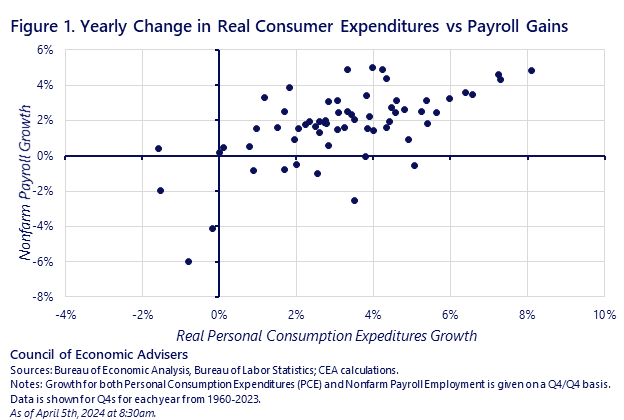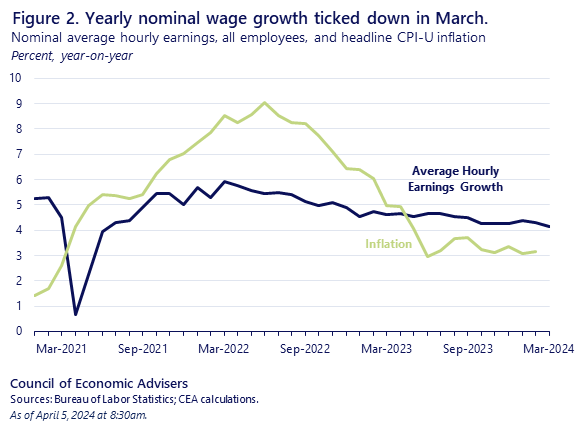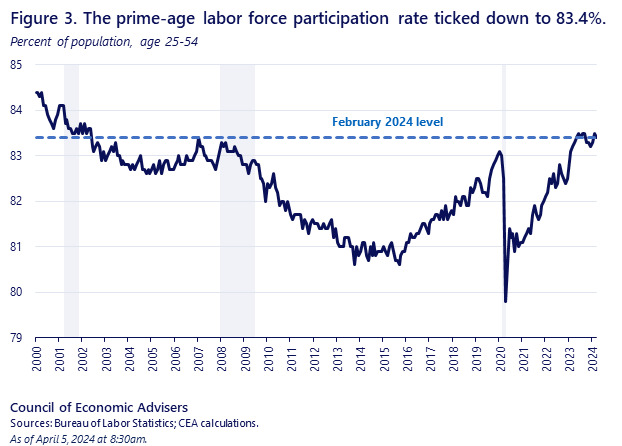In another strong jobs report, payrolls rose by 303,000 last month, well above expectations for 214,000 jobs added. CEA brings you the details of the report in our topic X, including the decrease in the unemployment rate and the increase in the labor force participation rate. In this blog, we wanted to explore why the job market has consistently outperformed expectations. That said, above March expectations figures are not unusual in recent employment reports. What does this consistent and lopsided shortage tell us about the US labor market?
An answer to the question begins with the simple econ 101 observation that labor demand is “derived demand,” meaning that it is derived from consumer demand for goods and services, as well as demand for investment inputs. As the chart below shows, annual percentage changes in real consumer spending and job growth are strikingly positively correlated. Throughout much of this current expansion, many forecasters have also lowered their growth expectations, and this in turn has led to systematic reductions in job growth expectations.

Scatterplots show correlation, not causation, and the one above is no different. Yes, the “derived demand” model argues that solid spending and investment, driven in part by the strong private sector response to the investment incentives in the IRA and CHIP legislation, are causally related to employment. Businesses need workers to meet the level of demand for their products, and firms that fail to heed this signal risk leaving profits on the table.
But it’s also the case that stronger employment growth spurs greater demand—consumption and investment—putting more money in people’s pockets. The figure below shows how wage growth has been ahead of price growth for nearly a year now. We learned this morning that wages rose by 4.1% over the past year. We don’t have inflation for March yet (we’ll have it on Wednesday next week), but in February, it rose 3.2% over the year, well below the recent trend in wage growth.

In other words, the scatterplot represents a virtuous cycle in which strong job growth supports solid spending and spending supports jobs. Rinse and repeat!
Another important piece of good news in today’s report is that the labor force participation rate increased by 0.2 pp CEA tends to focus on prime-age workers (ages 25-54), as shown in the figure below. Their rate fell by 0.1 pp in March, but as you can see, it has rebounded strongly in recent years as the persistently tight labor market has pulled many workers from the sidelines.

This dynamic of a rapidly growing workforce may also help explain the patterns that defy expectations we’ve seen. In a previous blog, we discussed this in terms of what labor economists call the “breakthrough level of job growth,” or EU. Conventional EU estimates tend to cluster around 100,000. But over the past year, the average monthly job gain has been 244,000. As we wrote in our previous blog, “EU logic implies that if actual job growth outpaces the EU, unemployment must fall.” But the fact is that actual monthly job gains have far outpaced the EU, while the unemployment rate is firmly entrenched in the 3.5-3.9 percent range (3.8% in March).
EU logic tells us that if job gains outpace the EU but the unemployment rate is broadly stable, the labor force may grow faster than we thought (see below for additional sources of uncertainty that could to complicate arithmetic). We will have more to say about this in future analyses, but many economists examining this question doubt that faster labor force growth is a plausible explanation for this EU conundrum, which in turn helps to explained the lack of expectations.
A final point that should never be overlooked in this research is that initial labor market data is not the final word. For example, job gains in the payroll survey undergo several rounds of revisions, including a benchmarking of administrative data from unemployment insurance tax data. Household survey estimates are derived from a relatively small survey and are also subject to error. And, both payroll and household survey estimates have been revised over several years to account for emerging seasonal patterns. Therefore, it is possible that some of the divergence between the latest payroll estimates and the EU norm may be revised.
We will continue to closely monitor these developments, including the virtuous cycle, workforce growth and data revisions.
#Employment #Situation #March #Rinse #Repeat #virtuous #cycle #labor #market #CEA #White #House
Image Source : www.whitehouse.gov